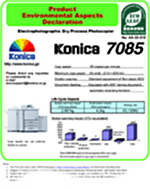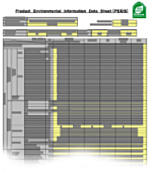To ensure the objectivity and consistency of the information declared, which allows purchasers to make an informed desiciton, there should be a uniformity in the following definitions;
- 1. The requirements and rules of the LCA calculation
- 2. The scenarios of product use and disposal
- 3. The methods of data collection, processing and use
- 4. The data to be disclosed.
The Product Category Rule (PCR) functions as a criteria by which to set rules for LCA calculations for each product category, originally developed by PCR working group (PCR-WG) adhering to the "Requirements for the EcoLeaf PCR", then reviewed and authorized by the PCR committee.
The PCRs are the cornerstone of the EcoLeaf label; listed here.
Data verification is the process of confirming whether the LCA study has been appropriately conducted, the data based on the LCA study conform to the PCR, and the label information is exhaustive, accurate, objective, and transparent. Data can be verified either internally or externally.
External verification applies to companies whose data collection system has not been certified. The verification standards and the qualification of external verifiers are the same as those for internal verification (see Section 4.3 and Chapter 6). External verifiers should submit to the EcoLeaf program office the verification result report. The review committee then makes judgment on the report. When the committee approves the report, the company can register and release the EcoLeaf label (see Section 4.3).
If a company intends to prepare EcoLeaf label demonstrates certain level of performance on its internal business operation systems for label development and publication: data collection/processing, verification, and registration/publication systems, the company can be certified to verify its own data collection by itself. This way of certification is called as "System Certification". Once the company obtained System Certification, it can verify collected data internally (internal verification) and thereby manage label development and publication work by itself for three years.
See the guideline “4.3: Product environmental data validation criteria and procedures”.
The EcoLeaf label is published as a set of 3 sheets, the basic element can be seen below.
The PEAD provides representative information on the product, including scale/degree of environmental impact. It should be prepared concisely but in a highly uniform and visual way that product purchasers can easily understand. Below the main text part, other environment-related information may also be presented, provided that its accuracy can be confirmed.

Overall results of the LCA are presented on the PEIDS to clarify the basis of the PEAD and to summarize the results of inventory analysis, impact assessment, and energy consumption.
Inventory analysis ( based on the LCA method) calculates and evaluates the amount of energy, raw materials, and environmental contaminants associated with a product during its life cycle. Impact assessment correlates the results of inventory analysis with indicators such as the consumption of exhaustible resources and the emission loads that indicate the level of global warming and ozone depletion, enhancing the ease of understanding for the general public.

The product data sheet records the underlying data used in the preparation of the PEIDS. The company introducing EcoLeaf label prepares the product data sheet by describing the inputs and outputs of energy, raw materials, and environmental contaminants per product unit based on actual measurements within its direct range of influence (e.g., within its factory).

JEMAI believe the EcoLeaf program will benefit those who are striving to develop eco-conscious products and services. The latest labels developed are listed here.





